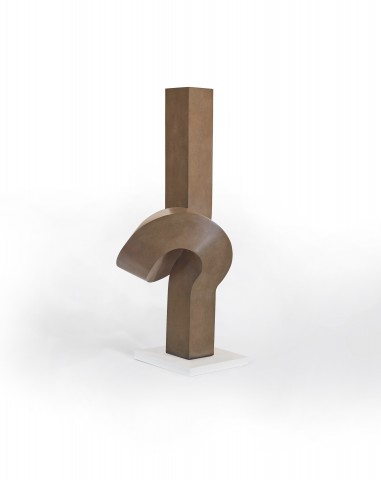MEDITATION, 1974
CLEMENT MEADMORE
bronze
99.0 cm height
signed, dated and numbered at base: Meadmore 1974 6/6
Peter Beckwith, Perth
Thence by descent
Estate of Valerie Beckwith, Perth
Margaret Moore, Perth
Private collection, Perth, acquired from the above December 2005
Gibson, E., The Sculpture of Clement Meadmore, Hudson Hills Press, New York, 1994, p. 72 (illus. another example)
There exists a little-known problem that is recognised by serious sculptors: how to make inert material appear alive. In other words, how to make hard substance look pliant. A close scrutiny of the life-like hands of Michelangelo’s famous Pietà in Rome reveals that even he toiled over the successful resolution of this enduring challenge in the art of sculpture.
Deep within the structures of Clement Meadmore’s sculptures lies evidence of the same aesthetic tussle: there is always in his sculptures the felt sense that unyielding metal has been ‘bent’ to the artistic aim of the artist. Metal is made to do what one thinks it cannot - not wilfully so, but in order to embody a new and extended aesthetic experience. These two factors lie at the core of the tight dynamism ensconced within Meadmore’s sculptures. They twist; they turn, they writhe and in their suggested animation, they add a humanising and contrapuntal balance to the all-to-often bland immobility and visual harshness of our built environments. Meadmore is Minimalism without sterility.
This type of incorporated dynamism is already evident in his famous Sling Chair, 1963 (manufactured in 1981) with its curve set within a rectangle format – it was unpadded, it was crisp and bold, it was simple. It was also his last creation before he, with some rancour, left Australia to live in New York, where his sculptural projects flourished apace. Even in that elegant chair design in Melbourne, Meadmore displayed an almost uncanny feel for the harmonised balance of form and line, of positive and negative spaces and of visual weight – a type of optical ‘meatiness’ that asserted its own place in the physical world.
In New York, the unadorned ‘purity’ of these formational attributes quickly endeared him to the major artists of the American movement of Minimalism: Donald Judd, Tony Smith, Richard Serra, Frank Stella and others. Their purified strictures suited Meadmore’s inherent formalism. His successes, thereafter, were truly remarkable.
Meadmore’s Meditation, 1974, a bronze cast work from a limited edition of six, is a domestic-sized sculpture that epitomises all the attributes that make his works so visually distinctive. Its intimation of ‘coiled’ power is made more evident by contrast with the simple linearity of its upper and lower sections. Taken as a whole, Meadmore’s bronze has sentinel-like composure. We have no way of knowing with certainty, but it is possible that Meadmore was taken by the elegant power of some standing hatha yoga poses where focal energy is concentrated mid-body. Meadmore’s visual acuity would have appreciated and noted the structural underpinnings of such positions – just as André Masson and Pablo Picasso admired and emulated the free lines of mooring ropes lying on piers (no loose rope is ‘uptight’).
Whatever the case, the prime visual impact of Meadmore’s Meditation relies upon its emphasis upon a characteristically compressed tautness that is almost calligraphic in its fixed-in-space elegance. It’s a hallmark sculpture that not only sits firmly anchored in space, but also, like all good sculpture, adds to place.
KEN WACH
